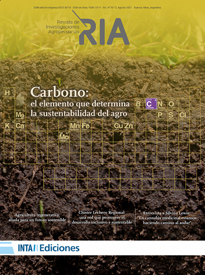Ver ítem
- xmlui.general.dspace_homeCentros Regionales y EEAsCentro Regional CórdobaEEA Marcos JuárezArtículos científicosxmlui.ArtifactBrowser.ItemViewer.trail
- Inicio
- Centros Regionales y EEAs
- Centro Regional Córdoba
- EEA Marcos Juárez
- Artículos científicos
- Ver ítem
Efecto de la concentración salina y el regimen hídrico sobre la germinación, emergencia y establecimiento de alfalfa (Medicago sativa L.)
Resumen
Los suelos halo-hidromórficos de la región húmeda y subhúmeda de Argentina suman aproximadamente 20 millones de hectáreas, un amplio porcentaje de estos presentan vegetación nativa de baja producción de biomasa y consumo de agua. Entender el funcionamiento de especies forrajeras perennes como alfalfa en estos sitios es de suma importancia para mejorar la producción de los sistemas allí ubicados. El objetivo de este trabajo fue comprender y cuantificar el
[ver mas...]
Los suelos halo-hidromórficos de la región húmeda y subhúmeda de Argentina suman aproximadamente 20 millones de hectáreas, un amplio porcentaje de estos presentan vegetación nativa de baja producción de biomasa y consumo de agua. Entender el funcionamiento de especies forrajeras perennes como alfalfa en estos sitios es de suma importancia para mejorar la producción de los sistemas allí ubicados. El objetivo de este trabajo fue comprender y cuantificar el efecto de la salinidad y el contenido hídrico edáfico sobre la germinación, emergencia y establecimiento temprano del cultivo de alfalfa. Así se realizaron tres experimentos a diferentes escalas: (E1) experimento en cámara de germinación, con el fin de determinar, bajo condiciones controladas, el efecto de diferentes condiciones de salinidad y disponibilidad hídrica sobre la germinación y emergencia de alfalfa; (E2) un experimento en invernáculo para evaluar el efecto del estrés hídrico (por exceso o por defecto) sobre plantas de alfalfa en la etapa de establecimiento temprano; y (E3) un experimento a campo, con el fin de identificar y jerarquizar indicadores ambientales determinantes de la emergencia, establecimiento y producción del cultivo de alfalfa. Se halló que en ambientes halo-hidromórficos la concentración salina fue la principal variable determinante del crecimiento y supervivencia de la especie durante las etapas tempranas con límites cercanos
a 4 dS.m-1. El exceso o déficit hídrico afectó al stand de plantas, reduciendo a la mitad el número de individuos. La plasticidad fenotípica de la alfalfa frente a diferentes tenores salinos, así como al estrés hídrico (por exceso o por defecto) determina que sea una especie para considerar cuando se pretende producir biomasa de alta calidad, distribuida en el tiempo, en este tipo de ambientes.
[Cerrar]
The halo-hydromorphic soils of the humid and sub-humid region of Argentina cover approximately 20 million hectares. A large proportion of them have native vegetation with low biomass production and water consumption. Understanding the functioning of perennial forage species such as alfalfa in these sites is of paramount importance to improve the productivity of the grazing systems located there. The objective of this work is to understand and quantify the
[ver mas...]
The halo-hydromorphic soils of the humid and sub-humid region of Argentina cover approximately 20 million hectares. A large proportion of them have native vegetation with low biomass production and water consumption. Understanding the functioning of perennial forage species such as alfalfa in these sites is of paramount importance to improve the productivity of the grazing systems located there. The objective of this work is to understand and quantify the effect of salinity and soil water content on the germination, emergence and early establishment of alfalfa. Three experiments were carried out at different scales: (E1) germination chamber experiment, to determine, under controlled conditions, the effect of different salinity and water availability conditions on the germination and emergence of alfalfa; (E2) a greenhouse experiment to assess the effect of water stress (by insufficiency or excess) on alfalfa plants in the early establishment stage; and (E3) a field experiment, to identify and rank environmental indicators that determine the emergence, establishment and production of alfalfa. It was found that, in halo-hydromorphic environments, saline concentration was the main variable affecting alfalfa growth and survival during the early stages, where salinity levels close to 4 dS.m-1. Water stress by excess or water deficit affected plant stands, halving the number of individuals. The phenotypic plasticity of alfalfa against different salinity and water conditions, makes it a species to consider to produce high quality biomass, distributed over time, in this type of environment.
[Cerrar]

Autor
Bertram, Nicolas;
Alfonso, C.;
Grande, S.;
Chiacchiera, Sebastián;
Ohanian, Alfredo;
Bonvillani, Julieta;
Conde, María Belén;
Angeletti, Fernando Ramón;
Fuente
RIA 47 (2) : 267-272 (Agosto 2021)
Fecha
2021-08
Editorial
Ediciones INTA
ISSN
0325-8718
1669-2314
1669-2314
Formato
pdf
Tipo de documento
artículo
Palabras Claves
Derechos de acceso
Abierto
 Excepto donde se diga explicitamente, este item se publica bajo la siguiente descripción: Creative Commons Attribution-NonCommercial-ShareAlike 2.5 Unported (CC BY-NC-SA 2.5)
Excepto donde se diga explicitamente, este item se publica bajo la siguiente descripción: Creative Commons Attribution-NonCommercial-ShareAlike 2.5 Unported (CC BY-NC-SA 2.5)


